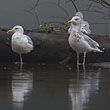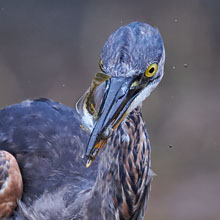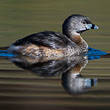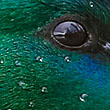Availability: Undetermined - Enquiries?
In the Field
Great Blue Heron 1 - Fish 0. Great Bear Rainforest, Northern BC Coast, Canada. September 25, 2017.
I captured this image in the heart of BC's Great Bear Rainforest in the autumn of 2017 (yes, there is a whole lot more to photograph in the Great Bear besides "just" bears!). Although this subspecies of Great Blue Heron has a conservation designation of "Special Concern" (i.e., "next to Threatened") in Canada, we see them quite commonly in the Great Bear. Generally the herons of the fannini subspecies are quite shy and almost never allow close approach. However, this bird was exceptionally pre-occupied with fishing and pretty much ignored us! In this shot the heron has just successfully nabbed a small fish and is about to flip it into the "correct" position for swallowing. Water droplets (presumably from the flipping fish) are visible around the heron's head.
I captured this shot using a Nikon D850. And I'm posting it here to make a few points about something a LOT of wildlife photographers like about the D850 - how much you can CROP with it! To be fully clear, the image you're seeing above (before resolution reduction for web display) is a HUGE crop. Its dimensions are only 2699 x 1799 pixels and the original shot BEFORE cropping was 8256 x 5504 pixels. So what you're looking at is only 10.7% of the full-frame, uncropped image!
If one wants to make such massive crops and still end up with usable images there are a couple things to keep in mind. First, the full-resolution original image better be really, really sharp! You lose the ability to rely on resolution reduction for "faux-sharpening" when you are cropping as dramatically as this. Part of this "it better be sharp" constraint is associated with lens choice - getting an image sharp enough for this much cropping means you better be using a lens that is flaw-free enough so that the D850 doesn't "beat it up" (meaning that its high resolution doesn't expose a lot of flaws that might be trivial and unnoticeable on a lower resolution camera). In this case the image was shot with a Nikkor 400mm f2.8E VR lens, a lens is crazy sharp and continues to exhibit its magic on the D850. But the D850 DOES beat up many lenses - you wouldn't want to shooting this shoot with many zoom lenses (especially a zoom with a teleconverter on it or engaged). Would you be able to shoot this shot with the new Nikkor 180-400mm f4E VR and still be able to crop it this much? Don't know yet (the jury is still out on how that lens REALLY performs at 400mm, both with and without the TC engaged).
Second, if you are going to make massive crops you have to start with a pretty noise-free image. Why? Well, with extreme crops you have little room left to reduce the resolution of the image on your computer, and during resolution-reduction you hide a lot of image noise. If you judge noise on a D850 at 100% resolution (especially when viewing the image at 100% magnification) you'll find the images show more noise than all other current Nikon full-frame cameras and even more noise than the D500. If you take a full-frame D850 image file and reduce it down to the size needed to print an 8x10 print (as dxomark.com does) of course it looks quite clean, but that's only after you have thrown the majority of the pixels away! BUT...you don't have this luxury if you're making massive crops. This image was captured at ISO 720 and with selective noise reduction I was able to make the image look quite clean (at least with respect to noise!), but you sure the heck wouldn't have wanted to shoot this image at ISO 3200 and crop down to this size (the image noise would have started to obscure detail in the subject).
Doing extreme cropping with a D850 IS possible...but you won't do it successfully using sloppy technique or with "less than stellar" lenses!
Here's a larger (2400 pixel) version of this shot for anyone caring to do a little pixel-peeping:
• Great Blue Heron 1 - Fish 0: Download 2400 pixel image (JPEG: 1.1 MB)
ADDITIONAL NOTES:
1. This image was captured during my autumn"Into the Great Bear Rainforest" Instructional photo tour in the summer of 2017. Each year I offer trips into two different parts of the Great Bear Rainforest as well as one to photograph marine mammals and oceanscapes near the northern tip of Vancouver Island. And, in selected years, I also offer photo tours to locations to capture other highly sought-after subjects, such as Dall Sheep, Bald Eagles, and more. Details about these trips can be found on the Photo Tours page of this website.
2. This image - in all resolutions - is protected by copyright. I'm fine with personal uses of them (including use as desktop backgrounds or screensavers on your own computer), but unauthorized commercial use of the image is prohibited by law. Thanks in advance for respecting my copyright!
3. Like all wildlife photographs on this website, this image was captured following the strict ethical guidelines described in The Wildlife FIRST! Principles of Photographer Conduct. I encourage all wildlife photographers to always put the welfare of their subjects above the value of their photographs.
Behind the Camera
Great Blue Heron 1 - Fish 0. Great Bear Rainforest, Northern BC Coast, Canada. September 25, 2017.
Digital Capture; Compressed RAW (NEF) 14-bit format; ISO 720.
Nikon D850 paired with Nikkor 400mm f2.8E. Hand-held from floating Zodiac. VR on and in Sport mode.
1/1250s @ f4.5; -0.33 stop compensation from "recommended" matrix-metered exposure setting.
At the Computer
Great Blue Heron 1 - Fish 0. Great Bear Rainforest, Northern BC Coast, Canada. September 25, 2017.
RAW Conversion to 16-bit TIFF, including all global and selective adjustments using Phase One's Capture One Pro 11. Selective local adjustments accomplished using Capture One Pro's layers and masking tools. In this case adjustments were made on 7 separate layers and included local/selective editing or application of noise reduction, exposure, colour desaturation, contrast (via a curves adjustment) and shadow recovery.
Photoshop adjustments were limited to image re-sizing, conversion of Prophoto RGB colour gamut (to sRGB), final sharpening for online display, and insertion of watermark.
Conservation
Great Blue Heron 1 - Fish 0. Great Bear Rainforest, Northern BC Coast, Canada. September 25, 2017.
Species Status in Canada*: This subspecies (Ardea herodias fannini) listed as of "Special Concern" in Canada.
While Great Blue Herons are distributed widely across North America, the fannini subspecies found west of the coastal mountains (in BC and the USA) has been showing significant population declines and now is represented by only approximately 8000 to 10,000 breeding pairs (with about half of those in BC).
The main factors threatening heron populations are nesting failure and reduced nesting productivity as a result of eagle predation, human disturbance and destruction of nesting and foraging habitats by residential and industrial development, road construction and logging.
In British Columbia, the Great Blue Heron, its nests and its eggs are protected by the province's Wildlife Act. The Great Blue Heron is protected by the Migratory Birds Convention Act, 1994. This Act prohibits the harming of birds, their nests or their eggs. No other recovery plan or action is currently in effect.
*as determined by COSEWIC: The Committee on the Status of Endangered Wildlife in Canada


























